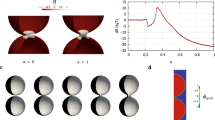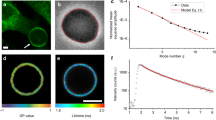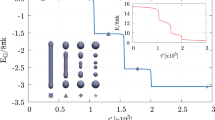Abstract
Maintaining the integrity of their protective plasma membrane is a primary requirement of cells. Accordingly, cellular events that breach the membrane are tightly regulated1. Artificial vesicles used in drug delivery must also stay intact until they have reached the desired target2. In both cases, the intrinsic resistance of the membrane to rupture must be overcome to allow the efflux of the vesicle's contents. Here, we use mesoscopic simulations3 to study the fusion of 28-nm-diameter vesicles to 50 × 50 nm2 planar membrane patches over 2 μs. We monitor the time evolution of 93 different fusion attempts. This allows us to construct a global morphology diagram, using the initial tensions of the vesicle and the planar membrane patch as control parameters, and to determine the corresponding fusion statistics. All successful fusion events are observed to occur within 350 ns, which reflects the presence of alternative pathways for the tension relaxation.
This is a preview of subscription content, access via your institution
Access options
Subscribe to this journal
Receive 12 print issues and online access
$259.00 per year
only $21.58 per issue
Buy this article
- Purchase on Springer Link
- Instant access to full article PDF
Prices may be subject to local taxes which are calculated during checkout




Similar content being viewed by others
References
Alberts, B. et al. Molecular Biology of the Cell 2nd edn (Garland, New York, 1989).
Lasic, D. D. in Vesicles (ed. Rosoff, M.) Ch. 10 (Surfactant Science Series vol. 62, Marcel Dekker, New York, 1995).
Shillcock, J. C. & Lipowsky, R. Equilibrium structure and lateral stress distribution of amphiphilic bilayers from dissipative particle dynamics. J. Chem. Phys. 117, 5048–5061 (2002).
Jahn, R. & Grubmüller, H. Membrane fusion. Curr. Opin. Cell Biology 14, 488–495 (2002).
Mayer, A. Membrane fusion in eukaryotic cells. Annu. Rev. Cell. Dev. Biol. 18, 289–314 (2002).
Lindau, M. & de Toledo, G. A. The fusion pore. Biochim. Biophys. Acta 1641, 167–173 (2003).
Ohta-lino, S. et al. Fast lipid disorientation at the onset of membrane fusion revealed by moleculer Dynamics simulations. Biophys. J. 81, 217–224 (2001).
Marrink, S. J. & Mark, A. E. The mechanism of vesicle fusion as revealed by molecular dynamics simulations. J. Am. Chem. Soc. 125, 11144–11145 (2003).
Stevens, M. J., Hoh, J. H. & Woolf, T. B. Insights into the molecular mechanism of membrane fusion from simulation: evidence for the association of splayed tails. Phys. Rev. Lett. 91, 188102 (2003).
Chanturiya, A., Scaria, P., Kuksenok, O. & Woodle, M. C. Probing the mechanism of fusion in a two-dimensional computer simulation. Biophys. J. 82, 3072–3080 (2002).
Noguchi, H. & Takasu, M. Fusion pathways of vesicles: a Brownian dynamics simulation. J. Chem. Phys. 115, 9547–9551 (2001).
Siegel, D. P. The modified stalk mechanism of lamellar/inverted phase transitions and its implications for membrane fusion. Biophys. J. 76, 291–313 (1999).
Markin, V. S. & Albanesi, J. P. Membrane fusion: stalk model revisited. Biophys. J. 82, 693–712 (2002).
Mueller, M., Katsov, K. & Schick, M. A new mechanism of model membrane fusion determined from Monte Carlo simulation. Biophys. J. 85, 1611–1623 (2003).
Hoogerbrugge, P. J. & Koelman, J. M. V. A. Simulating microscopic hydrodynamic phenomena with dissipative particle dynamics. Europhys. Lett. 19, 155–160 (1992).
Kranenburg, M., Venturoli, M. & Smit, B. Molecular simulations of mesoscopic bilayer phases. Phys. Rev. E. 67, 060901 (2003).
Yamamoto, S., Maruyama, Y. & Hyodo, S. Dissipative particle dynamics study of spontaneous vesicle formation of amphiphilic molecules. J. Chem. Phys. 116, 5842–5849 (2002).
Groot, R. D. & Warren, P. B. Dissipative particle dynamics: bridging the gap between atomistic and mesoscopic simulation. J. Chem. Phys. 107, 4423–4435 (1997).
Vattulainen, I., Karttunen, M., Besold, G. & Polson, J. M. Integration schemes for dissipative particle dynamics simulations: from softly interacting systems to hybrid models. J. Chem. Phys. 116, 3967–3979 (2002).
Warren, P. B. Dissipative particle dynamics. Curr. Opin. Colloid Interface Sci. 3, 620–624 (1998).
Nielsen, S. O., Lopez, C. F., Srinivas, G. & Klein, M. L. Coarse grain models and the computer simulation of soft materials. J. Phys. Chem. B. 108, 8153–8160 (2004).
McNew, J. A. et al. Close is not enough: SNARE-dependent membrane fusion requires an active mechanism that transduces force to membrane anchors. J. Cell Biol. 150, 105–117 (2000).
Yersin, A. et al. Interactions between synaptic vesicle fusion proteins explored by atomic force microscopy. Proc. Natl Acad. Sci. USA 100, 8736–8741 (2003).
Acknowledgements
We thank Erwin Neher for helpful correspondence and acknowledge support by the Human Frontier Science Project through research grant RGP0072/2003. We also thank one of the reviewers for their rather detailed comments on the first version of this manuscript.
Author information
Authors and Affiliations
Corresponding author
Ethics declarations
Competing interests
The authors declare no competing financial interests.
Supplementary information
Supplementary Information
Supplementary figures S1 and S2; table S1 (PDF 3569 kb)
Supplementary Information
Supplementary movie (E) (MOV 3083 kb)
Rights and permissions
About this article
Cite this article
Shillcock, J., Lipowsky, R. Tension-induced fusion of bilayer membranes and vesicles. Nature Mater 4, 225–228 (2005). https://doi.org/10.1038/nmat1333
Received:
Accepted:
Published:
Issue Date:
DOI: https://doi.org/10.1038/nmat1333
This article is cited by
-
Activation energy and force fields during topological transitions of fluid lipid vesicles
Communications Physics (2022)
-
How proteins open fusion pores: insights from molecular simulations
European Biophysics Journal (2021)
-
Cell–substrate traction force regulates the fusion of osteoclast precursors through cell–cell interaction
Biomechanics and Modeling in Mechanobiology (2020)
-
Shear-induced microstructures and dynamics processes of phospholipid cylinders in solutions
Scientific Reports (2019)
-
Bayesian selection for coarse-grained models of liquid water
Scientific Reports (2019)



